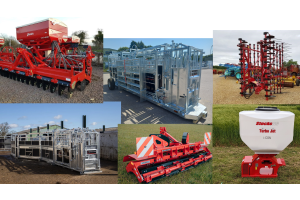Cabbage Stem Flea Beetle Control (Updated 2019)

A few days ago, after seeing a post on twitter about flea beetle, one of my colleagues gave me this interesting topic to mull over... After a little bit of sleuthing around the subject, I discovered that if I so desired, I could probably set any agricultural chat site alight with the words ‘cabbage stem flea beetle’ alone. So clearly this topic has suddenly become quite combustible this Autumn – but why, I hear you ask.
What is Cabbage Stem Flea Beetle?
The Cabbage Stem Flea Beetle (widespread in both Europe and the UK) typically migrate into oilseed rape crops during crop emergence, at the crops most vulnerable stage, which takes place around this time of year. In severe cases of damage, the beetles can feed on and destroy the seedling before it has even emerged. Equally as damaging is ‘shot-holing’, when the beetles pummel the early leaves, leaving the plant’s growth seriously stunted.
What does Cabbage Stem Flea Beetle look like?
Images below show the Flea Beetle on the left and its larvae on the right:


Why was 2018 so bad for Cabbage Stem Flea Beetle?
In 2018, in some cases, damage has caused growers in Eastern soils to write off entire fields, in places where damage had previously never been serious enough to warrant treatment. Since air temperatures above 16 degrees are more favourable for CSFB migration, the warm July and August have caused flea beetle numbers to soar, with sobering oilseed rape crop losses.
The EU ban on the use of neonicotinoid seed dressing also means that oilseed rape farmers battling the beetles have their hands tied, and essentially have nothing remaining in their armoury save outdated pyrethroids and broad-spectrum insecticide. While the ban on neonics had the protection of bees and pollinators in mind, it is arguable that inaccurate broad spectrum-insecticide sprays and foliar applications used in place of neonics would needlessly kill a greater number of insects and do a poor and job at targeting the beetles.
How can I tell if my crops have Cabbage Stem Flea Beetle damage?
Extensive crop damage should be obvious, the beetles will often be visible in the crop, and seedlings will show the typical ‘shot-holing’ characteristic– series’ of small holes in the early leaves. You should typically look out for small (3-5mm) black jumping insects with long antennae and large hind legs. Larvae are neutral coloured, with tiny dark spots, and a black head and tail.
What can I do if my crops have Cabbage Stem Flea Beetle damage?
- Entomologists would suggest spraying Flea-Beetle damaged oilseed rape at night, as this is when the beetles are most active
- Thinking ahead, fields at closest proximity to previously oilseed rape fields are high-risk areas
- Damage should be treated at the first sign of an attack, with full dosage (this best tackles pyrethroid resistance issues)
- Some bodies suggest companion cropping, where white mustard is grown as a sacrificial crop near oilseed rape, to reduce grazing damage by adult beetles. It is thought that the white mustard (being also a brassica like oilseed rape) would lure the beetles away from feeding on the oilseed rape.
- Spreading slurry before cultivation has also been found beneficial, as this retains moisture and nutrition needed for successful crop establishment
2019 update
So, I wrote the above blog about 11 months ago, when the cabbage stem flea beetle phenomenon was first revealed to me as an ag newbie. With the scorching summer of 2018 now a distant memory from the comparative sogginess of 2019, we can reflect on the result of the higher temperatures on CSFB and this year’s OSR harvest.
It’s probably right to say that the OSR Harvest of 2019 was sort of anticipated by growers as a ‘big reveal’, as worries loomed of stunted growth and poor yields because of high CSFB numbers around drilling time last year, that led to many farmers re-drilling or abandoning OSR altogether.
Many in CSFB hotspots have reported severe damage due to infestations. Results show that areas of OSR that received little or no rain post drilling were severely affected, as needed moisture was not there to facilitate good crop establishment before the critters pounced.
In some places, yield losses of up to 0.5t/ha in OSR were attributed to CSFB, with overall yields as low as 1.17 t/ha in recognized CSFB hotspots. Results also show that early-drilled crops were relentlessly molested by CSFB. In some areas, damage has been serious enough to warrant the combine writing off the crop at point of harvest.
Overall, a marked decline in yields can be traced since the withdrawal of neonicotinoids. On reflection, growers favour manure spreading on would-be OSR fields. Muck masks the smell that brassicas emit, which is attractive to flea beetles. It also provides nutrition and retains moisture.
Others suggest adjusting rotations, and delaying drilling this year until rain is forecast, which should enable seed to get away. Some growers have also voiced belief that use of ammonia in fertiliser can help deter flea beetles.
Keep us posted with how your #Harvest2019 is going and what the results of CSFB numbers are in your patch .
Images courtesy of: naturespot.org.uk & johnterahsmiley.com






